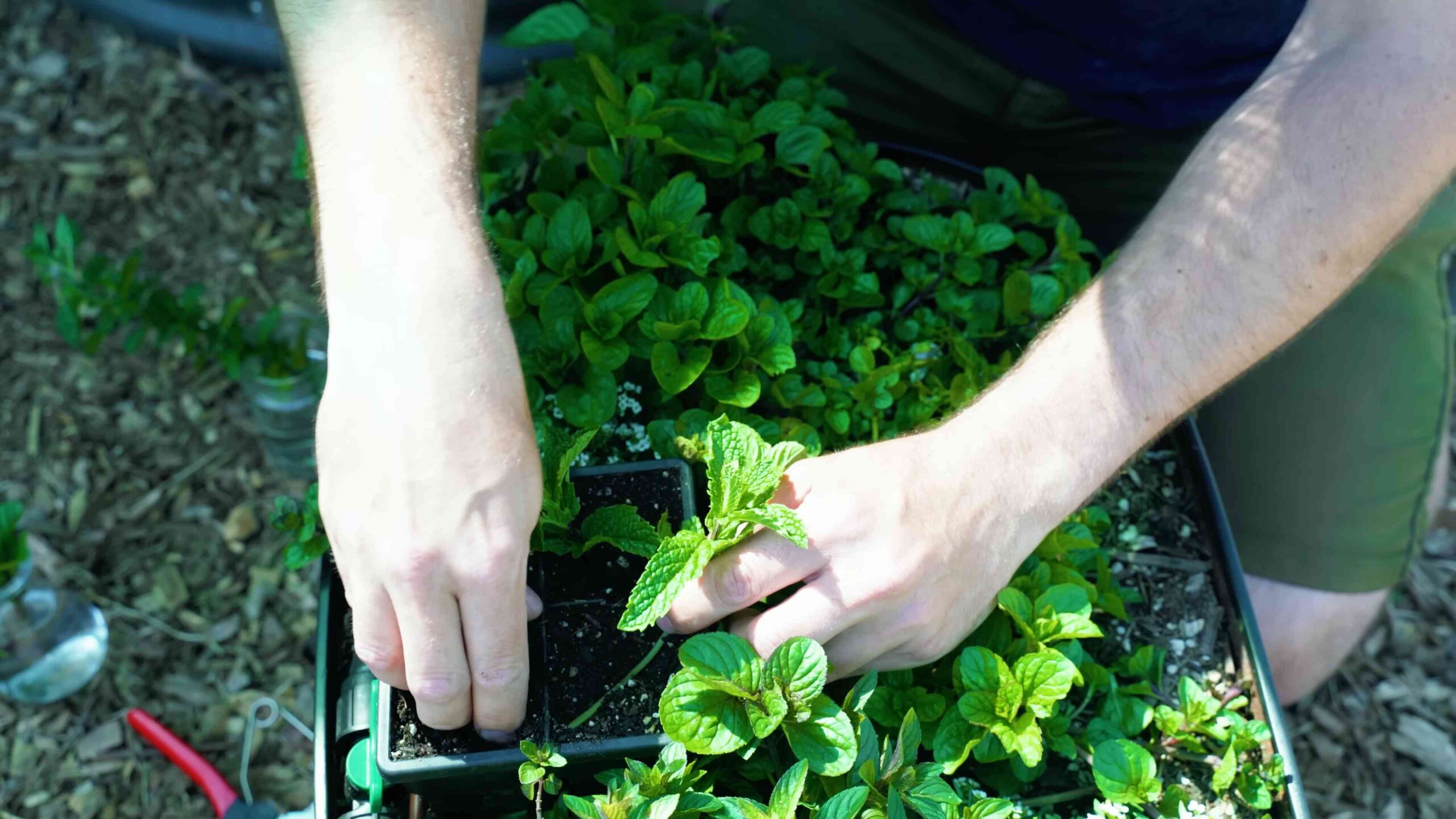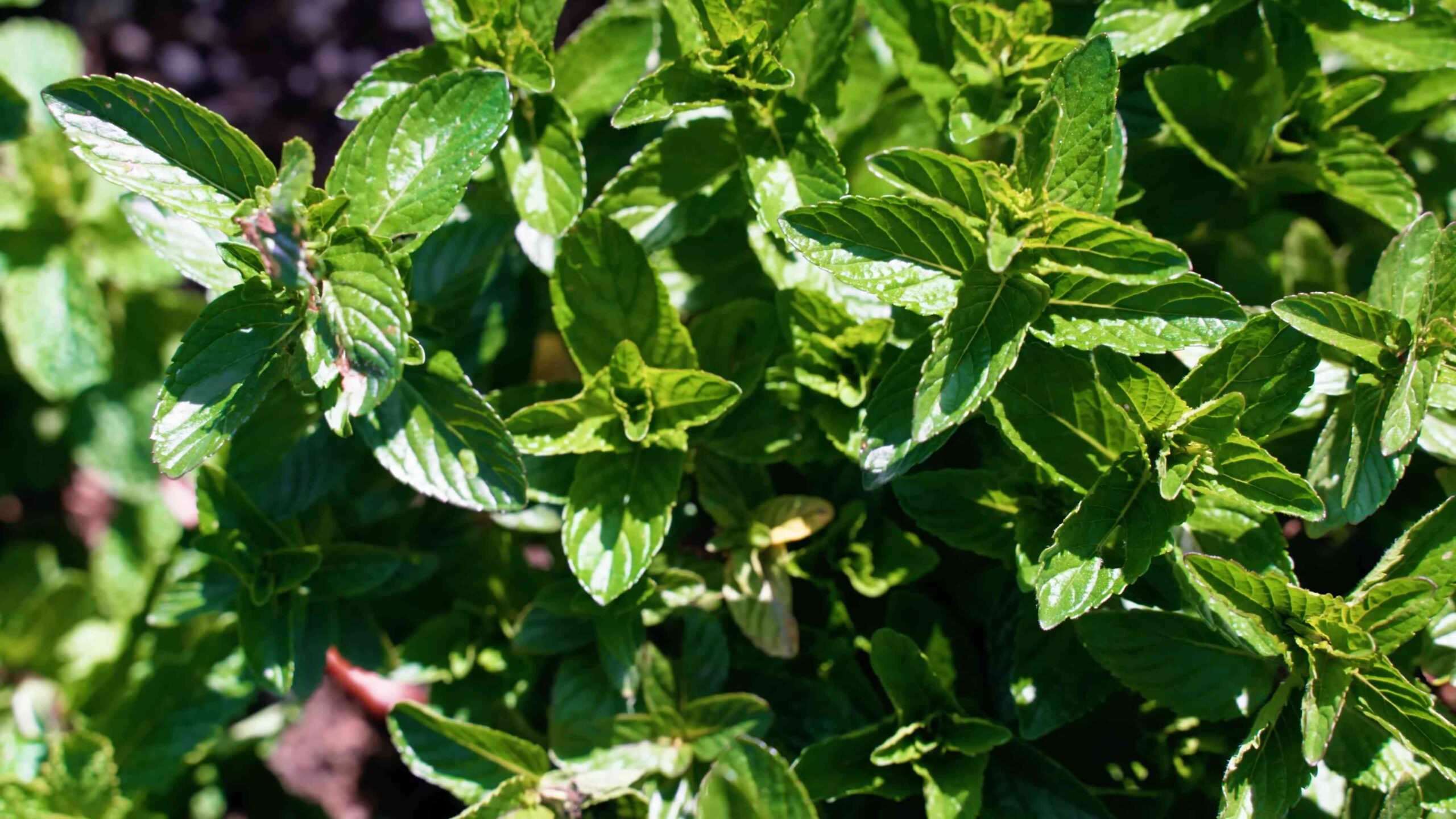Grow Mint at Home and unlock a world of fresh flavors and fragrant aromas right at your fingertips! Have you ever dreamed of snipping fresh mint leaves for a refreshing mojito or adding a vibrant touch to your summer salads? Well, dream no more! This DIY guide will empower you to cultivate your own thriving mint patch, regardless of your gardening experience.
Mint, with its rich history dating back to ancient civilizations, has been cherished for its culinary and medicinal properties for centuries. From the Egyptians using it in their rituals to the Romans flavoring their sauces, mint has always held a special place in human culture. Today, we can easily bring this historical herb into our homes.
But why should you bother learning how to grow mint at home? Simple! Store-bought mint can be expensive and often lacks the intense flavor of freshly grown leaves. Plus, growing your own mint is incredibly rewarding and sustainable. Imagine the satisfaction of harvesting your own herbs, knowing exactly where they came from and how they were grown. This DIY trick will save you money, enhance your culinary creations, and add a touch of green to your living space. Let’s get started!

Grow Your Own Mint: A Beginner’s Guide to a Thriving Herb Garden
Hey there, fellow plant enthusiasts! Ever dreamt of having fresh, fragrant mint readily available for your mojitos, teas, or culinary creations? Well, dream no more! Growing mint at home is surprisingly easy, even if you don’t have a green thumb. I’m going to walk you through everything you need to know to cultivate a flourishing mint patch, whether you choose to grow it in a pot indoors or directly in your garden. Let’s get started!
Choosing Your Mint Variety
First things first, let’s talk about the different types of mint. There’s more than just your standard peppermint and spearmint! Each variety has its own unique flavor profile and aroma. Here are a few popular options:
- Peppermint: The classic, strong mint flavor, perfect for teas and candies.
- Spearmint: A milder, sweeter mint, ideal for mojitos and sauces.
- Chocolate Mint: A delightful combination of mint and chocolate, great for desserts.
- Apple Mint: A fruity, slightly sweet mint, wonderful in salads and drinks.
- Orange Mint: A citrusy mint with a hint of orange, perfect for adding a unique twist to your recipes.
I recommend starting with either peppermint or spearmint, as they are readily available and relatively easy to grow. Once you’ve mastered those, you can branch out and experiment with other varieties!
Gathering Your Supplies
Before we dive into the planting process, let’s make sure you have everything you need. Here’s a checklist:
- Mint Seeds or a Mint Plant: You can start from seeds, but I find it much easier to begin with a small plant from your local nursery or garden center.
- Pot or Garden Space: If you’re growing in a pot, choose one that’s at least 6 inches in diameter. If you’re planting in your garden, make sure you have a designated area for your mint.
- Potting Soil or Garden Soil: Use a well-draining potting mix for containers. If you’re planting in the garden, amend your soil with compost or other organic matter to improve drainage and fertility.
- Watering Can or Hose: You’ll need to water your mint regularly.
- Gardening Gloves (Optional): These will protect your hands from dirt and potential irritants.
- Pruning Shears or Scissors: For harvesting and maintaining your mint.
Planting Your Mint
Now for the fun part! Let’s get your mint planted and on its way to becoming a thriving herb.
Planting in a Pot
1. Prepare the Pot: Fill your pot with potting soil, leaving about an inch of space at the top.
2. Plant the Mint: If you’re starting with a plant, gently remove it from its container and loosen the roots. Place the plant in the center of the pot and fill in around it with more potting soil. If you’re starting from seeds, sprinkle them evenly over the surface of the soil and lightly cover them with a thin layer of soil.
3. Water Thoroughly: Water the soil until it’s evenly moist but not soggy.
4. Find a Sunny Spot: Place your pot in a location that receives at least 4-6 hours of sunlight per day. A windowsill or balcony is perfect.
Planting in the Garden
1. Choose Your Location Wisely: This is crucial! Mint is notorious for spreading aggressively. I highly recommend planting it in a container even within your garden to prevent it from taking over. If you insist on planting directly in the ground, choose a spot where it won’t interfere with other plants and consider burying a barrier around it (like a plastic or metal edging) to contain its roots.
2. Prepare the Soil: Dig a hole that’s slightly larger than the root ball of your mint plant. Amend the soil with compost or other organic matter to improve drainage and fertility.
3. Plant the Mint: Gently remove the plant from its container and loosen the roots. Place the plant in the hole and fill in around it with the amended soil.
4. Water Thoroughly: Water the soil until it’s evenly moist but not soggy.
5. Mulch (Optional): Add a layer of mulch around the base of the plant to help retain moisture and suppress weeds.
Caring for Your Mint
Once your mint is planted, it’s time to provide it with the care it needs to thrive.
1. Watering: Mint likes consistently moist soil, but it doesn’t like to be waterlogged. Water your mint whenever the top inch of soil feels dry to the touch. In hot weather, you may need to water it more frequently.
2. Sunlight: Mint thrives in full sun (6-8 hours of sunlight per day), but it can also tolerate partial shade (4-6 hours of sunlight per day). If you’re growing your mint indoors, make sure it’s getting enough light. You may need to supplement with a grow light if your windowsill doesn’t provide enough sunlight.
3. Fertilizing: Mint doesn’t require a lot of fertilizer, but a light feeding every few weeks can help it grow more vigorously. Use a balanced liquid fertilizer diluted to half strength.
4. Pruning: Regular pruning is essential for keeping your mint plant healthy and productive. Pinch off the top leaves of the plant to encourage it to branch out and become bushier. You can also remove any dead or yellowing leaves.
5. Pest Control: Mint is relatively pest-resistant, but it can occasionally be affected by aphids, spider mites, or whiteflies. If you notice any pests, try spraying them off with a strong stream of water. You can also use insecticidal soap or neem oil to control infestations.
6. Controlling Spread: As I mentioned earlier, mint is an aggressive grower. If you’re growing it in the garden, be sure to monitor its spread and prune it back regularly to prevent it from taking over. If you’re growing it in a pot, you may need to repot it into a larger container as it grows.
Harvesting Your Mint
The best part about growing your own mint is being able to harvest it whenever you need it!
1. When to Harvest: You can start harvesting mint leaves as soon as the plant is a few inches tall. The flavor is usually best before the plant flowers.
2. How to Harvest: Use pruning shears or scissors to cut off stems of mint leaves. You can harvest up to one-third of the plant at a time without harming it.
3. Storing Your Harvest: Freshly harvested mint leaves can be stored in the refrigerator for up to a week. Wrap them in a damp paper towel and place them in a plastic bag or container. You can also dry mint leaves for longer storage. To dry them, hang them upside down in a cool, dry place or use a dehydrator.
Troubleshooting Common Mint Problems
Even with the best care, you might encounter a few problems along the way. Here are some common issues and how to address them:
- Yellowing Leaves: This could be a sign of overwatering, underwatering, or nutrient deficiency. Check the soil moisture and adjust your watering accordingly. If the soil is dry, water more frequently. If the soil is soggy, allow it to dry out before watering again. You can also try fertilizing your mint with a balanced liquid fertilizer.
- Leggy Growth: This means your mint plant is stretching towards the light. Move it to a location with more sunlight or supplement with a grow light.
- Powdery Mildew: This is a fungal disease that appears as a white, powdery coating on the leaves. Improve air circulation around the plant and avoid overhead watering. You can also treat it with a fungicide.
- Pests: As mentioned earlier, mint can be affected by aphids, spider mites, or whiteflies. Spray them off with a strong stream of water or use insecticidal soap or neem oil.
Enjoying Your Homegrown Mint
Now that you’ve successfully grown your own mint, it’s time to enjoy the fruits (or rather, leaves) of your labor! Here are just a few ways to use your homegrown mint:
- Teas: Steep fresh mint leaves in hot water for a refreshing and soothing tea.
- Mojitos: Muddle mint leaves with lime juice, sugar, and rum for a classic mojito.
- Salads: Add chopped mint leaves to salads for a burst of fresh flavor.
- Sauces: Use mint to make sauces for lamb, chicken, or fish.
- Desserts: Add mint to desserts like chocolate mousse, ice cream, or fruit salads.
- Garnish:

Conclusion
So, there you have it! Growing mint at home is not just a whimsical garden project; it’s a practical, aromatic, and incredibly rewarding endeavor. We’ve walked through the simple steps, from choosing the right container to harvesting your fragrant bounty. But why is this DIY trick a must-try?
Firstly, consider the sheer convenience. Imagine needing a sprig of fresh mint for a mojito, a cup of tea, or a vibrant garnish for your lamb dish. Instead of rushing to the store and potentially settling for wilted, overpriced herbs, you simply step outside (or to your windowsill!) and snip off exactly what you need. This immediacy is a game-changer for any home cook or cocktail enthusiast.
Secondly, think about the cost savings. Buying fresh herbs regularly can quickly add up. A single mint plant, properly cared for, can provide you with a continuous supply for months, even years, effectively paying for itself many times over. It’s an investment in fresh flavor and a smart move for your wallet.
Thirdly, and perhaps most importantly, growing your own mint allows you to control the quality and source of your herbs. You know exactly what’s going into your plant – no harmful pesticides or questionable growing practices. You’re getting pure, unadulterated mint, bursting with flavor and aroma.
But the beauty of growing mint at home lies in its versatility. Feel free to experiment! Try different varieties of mint, such as peppermint, spearmint, chocolate mint, or even orange mint, each offering a unique flavor profile to explore. Consider planting your mint in decorative pots to add a touch of greenery and fragrance to your indoor spaces. You can also use your homegrown mint to create infused oils, vinegars, or even homemade mint extract. The possibilities are endless!
Don’t be afraid to get creative and adapt the techniques we’ve discussed to suit your own environment and preferences. Perhaps you live in a small apartment with limited sunlight – try using a grow light to supplement natural light. Or maybe you have a large garden – consider creating a dedicated mint bed, being mindful of its spreading tendencies.
We wholeheartedly encourage you to embark on this delightful journey of growing mint at home. It’s a simple, satisfying, and incredibly rewarding experience that will elevate your cooking, your cocktails, and your overall enjoyment of fresh herbs.
And now, the most important part: share your experience! We want to hear about your successes, your challenges, and your creative uses for your homegrown mint. Did you try a particular variety of mint that you absolutely loved? Did you discover a unique way to use your mint in a recipe? Share your stories and photos in the comments below. Let’s create a community of mint-loving gardeners and inspire others to discover the joy of growing their own fresh herbs. Happy growing!
Frequently Asked Questions (FAQ)
Why is my mint plant not growing well?
There are several reasons why your mint plant might be struggling. The most common culprits are inadequate sunlight, overwatering or underwatering, poor soil quality, and pests. Mint thrives in partial to full sunlight, so ensure it’s getting at least 4-6 hours of direct sunlight per day. Check the soil moisture regularly; it should be consistently moist but not waterlogged. Use a well-draining potting mix rich in organic matter. Inspect your plant for signs of pests like aphids or spider mites and treat them accordingly. Also, make sure your pot has drainage holes.
How often should I water my mint plant?
The frequency of watering depends on several factors, including the size of your pot, the type of soil, and the climate. As a general rule, water your mint plant when the top inch of soil feels dry to the touch. During hot, dry weather, you may need to water it more frequently. Avoid overwatering, as this can lead to root rot. A good way to check is to stick your finger into the soil. If it feels dry an inch down, it’s time to water.
What kind of soil is best for growing mint?
Mint prefers a well-draining soil that is rich in organic matter. A good potting mix for mint would include a combination of peat moss, perlite, and compost. You can also add some slow-release fertilizer to provide your plant with essential nutrients. Avoid using heavy clay soils, as they can retain too much moisture and lead to root rot.
How do I harvest mint leaves?
Harvesting mint leaves is easy! Simply snip off the stems just above a leaf node (the point where leaves grow from the stem). This will encourage the plant to branch out and produce more leaves. You can harvest mint leaves throughout the growing season. For the best flavor, harvest in the morning after the dew has dried.
My mint plant is spreading everywhere! How do I control it?
Mint is known for its aggressive spreading habits. If you’re growing mint in the ground, it’s best to contain it in a pot or raised bed to prevent it from taking over your garden. You can also use barriers, such as plastic edging, to prevent the roots from spreading. Regularly prune your mint plant to keep it under control. If you see runners (stems that grow horizontally along the ground), remove them promptly.
Can I grow mint indoors?
Yes, you can definitely grow mint indoors! Choose a sunny windowsill or use a grow light to provide your plant with adequate light. Use a well-draining potting mix and water regularly. Be sure to provide good air circulation to prevent fungal diseases. Indoor mint may not grow as vigorously as outdoor mint, but it can still provide you with a steady supply of fresh leaves.
What are some common pests and diseases that affect mint plants?
Common pests that affect mint plants include aphids, spider mites, and whiteflies. These pests can be controlled with insecticidal soap or neem oil. Fungal diseases, such as powdery mildew and rust, can also affect mint plants. To prevent these diseases, provide good air circulation and avoid overwatering. If you notice signs of disease, remove the affected leaves and treat the plant with a fungicide.
Can I propagate mint from cuttings?
Yes, propagating mint from cuttings is a very easy and effective way to get more mint plants. Simply take a cutting from a healthy stem, about 4-6 inches long. Remove the lower leaves and place the cutting in a glass of water. Roots should start to form within a week or two. Once the roots are about an inch long, you can plant the cutting in a pot of soil.
What are some creative ways to use my homegrown mint?
The possibilities are endless! Use it in teas, cocktails (like mojitos and mint juleps), salads, sauces, and desserts. You can also use it to make infused oils, vinegars, and syrups. Mint is a versatile herb that can add a refreshing flavor to a wide variety of dishes. Try adding it to your next batch of lemonade or using it as a garnish for grilled meats.
How do I store fresh mint leaves?
To store fresh mint leaves, wrap them in a damp paper towel and place them in a plastic bag in the refrigerator. This will help to keep them fresh for several days. You can also freeze mint leaves for longer storage. To freeze mint leaves, wash and dry them thoroughly, then place them in a single layer on a baking sheet. Freeze for a few hours, then transfer the frozen leaves to a freezer bag.





Leave a Comment